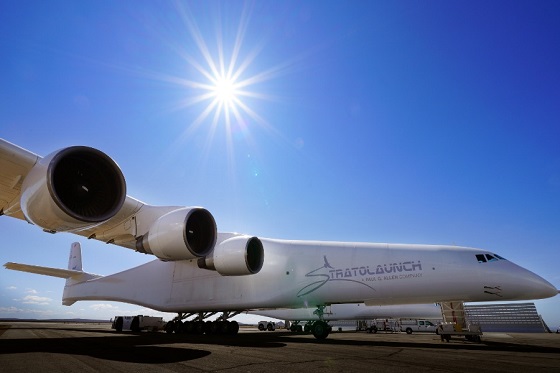World's largest airplane closer to use for space vehicles
Published : 04 May 2021, 00:09
In 1941, the U.S. government hired billionaire entrepreneur Howard Hughes to build a massive airplane to take some 700 American soldiers into combat. Hughes' legendary "Spruce Goose" had a wingspan of 320-feet (97.5 meters).
Last week - 80 years later - an even bigger aircraft, the "Stratolaunch," took to the skies over southern California's Mojave Desert, in a second successful test flight that awed onlookers marveling at its wingspan of 385 feet (117.3 meters) and six Boeing engines that roared in synchronicity.
The second successful test flight lasted 2.5 hours and the vehicle reached an altitude of 14,000-feet.
This massive aircraft, resembling two giant Boeing jets flying side-by-side, will not be transporting troops. Its use will be to launch rockets and space vehicles from high atmospheric locations, into the stars.
"Stratolaunch is advancing our nation's ability to be a worldwide leader in the hypersonic market," Stratolaunch Systems Chief Technology Officer Daniel R. Millman said in a statement last Friday. "Our flight today gets us another step closer to our promise of delivering the world's premier hypersonic flight test service."
Two years ago, Stratolaunch was airborne in first flight of world's largest aircraft, the Flightglobal.com headline read.
On Saturday, "the biggest airplane ever built now has two flights under its belt," LiveScience, a leading science news website in the United States, noted with excitement.
While the Hughes Aircraft H-4 Hercules, nicknamed the Spruce Goose, remains "the largest flying boat ever built," according to Flightglobal, it only achieved one successful test flight in 1947, and today sits inside a huge hangar for public viewing in McMinnville, Oregon.
Built of wood with eight massive propeller engines, the Goose pales in power and performance to the six Boeing 747-400 engines that propel the "all-composite" materials used in Stratolaunch, industry experts noted.
 But that was 80 years ago.
But that was 80 years ago.
Stratolaunch Systems tweeted a look at its mega-airplane performing flight test maneuvers in a dramatic 2:30 video.
The company called the plane "the world's largest all-composite aircraft" and structurally super-strong to carry other vehicles into thinner atmospheres for launching into space.
And while Hughes' Spruce Goose was close to the length of an American football field, the Stratolaunch even exceeds those dimensions.
"If you were to set Stratolaunch on an American football field, its wings would reach across each end zone," cnet.com said last week.
Stratolaunch, the company, was founded in 2011 by another successful entrepreneur, Microsoft co-founder Paul Allen, with a mission to create a high stratospheric platform to launch satellites into space, according to Digitaltrends.com.
After Allen passed in 2018, New York-based Cerberus Capital Management acquired the company in 2019, and Stratolaunch switched its focus to hypersonic testing and research, cnet.com said last week.
Stratolaunch describes the carrier aircraft as "a revolutionary launch pad for hypersonic and aerospace vehicles," designed to carry launch vehicles that can travel at hypersonic speeds reaching Mach 6, with a reusable Talon-A vehicle.
By stark comparison, the 1947 Spruce Goose's top speed was 235 miles (378.1 kilometers) per hour. The Talon-A is being designed to fly at 4,603 miles (7,406 kilometers) per hour.


